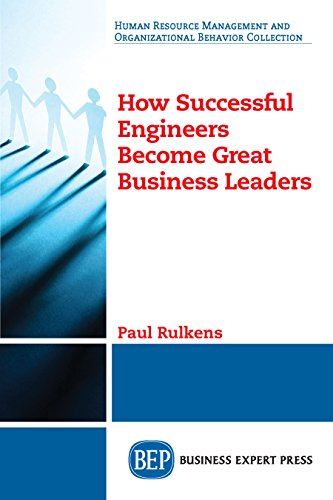By Gene Dixon, MBA, PhD, CPEM, FASEM, Executive Director of ASEM
About the Book

Author: Paul Rulkens
Title: How Successful Engineers Become Great Business Leaders
Publisher: Business Expert Express, 2018
ISBN-13:978-1-94784-368-4
Introduction
Spoiler alert: According to Rulkins, engineers can become organizational leaders. Even without an MBA.
Now that that is settled, why should you read the book? You should read the book because, like the management methods summaries of Blanchard and Johnson’s One Minute Manager, this book provides high level overviews of methods that the author has experienced and then tuned for engineers. It is a well-written treatise offering insights for engineers in a path towards organizational leadership. Not to be naïve, Rulkens notes there is an element of opportunity meeting preparation, or what we all know as luck, involved. Rulkens propositions that engineers are endowed with three basic strengths, or talents, that enables them to succeed at the highest levels of the organization: reality-based thinking, process design, and accelerated thinking. In discussing the uses of these strengths, he offers monographs of methods accompanied by 30 challenging questions. The questions, if taken seriously, will direct the reader to look inwardly while addressing and overcoming organizational challenges. This may seem oversimplified for those who want textbook level details to becoming a leader but the proof is in application. And, Rulkens intersperses his observations with vignettes and interviews that make his points clear.
The book is an easy read. Figure 1-2 hours depending on the reader’s comprehension speed (remember that accelerated learning strength?). Still there is plenty of mental and practical process (re)design within the 148 pages to comprehend and apply. I benefitted from a second read, however. Eventually, the engineer turned leader must stop the (book) analysis and get on with decision-making and goal achievement. Let me see if I can turn this review into a tease that will entice you to explore Rulkens’ work.
The Engineer's Superpowers
Rulkens describes the engineer’s superpowers - he calls them super-talents-like this:
-
Reality-based thinking is the ability to make decisions driven by data, the ability to clarify assumptions, and the ability to overcome systematic thinking bias such as self-selecting bias.
-
Process design is the application of process thinking to business challenges and systematic behavior testing to get different results using different processes. Another way to think about this is to ask, “What should not work, but is working anyway?”
-
Accelerated learning is defined by the speed, frequency and size/depth of the feedback and only happens when feedback from actions and experiments is fast, frequent, and significant.
According to Rulkens, it is possible for engineers to become great leaders by applying those superpowers in addressing the usual business challenges such as overcoming obstacles, crossing the valley of (innovation/project/etc.) death, strategic (re)alignment, avoiding stupid mistakes, eliminating contrary habits, and building the client network.
I recommend two chapters for a careful read, Effective Leadership Behaviors (5), and Goal-Achieving Blueprint (9). Thankfully, Rulkens stays away from the normal self-help banter with his personal insights in both chapters.
Critical Behaviors
When it comes to leadership behaviors, Rulkens crisply guides the reader through germane topics like boosting signal/decreasing noise, applying Poka Yoke, and putting the dead rat on the table. You’ll appreciate those more when you read the chapter. On a more serious note, Rulkens discusses 12 behavioral distinctions for attaining higher performance:
-
Playing to Win versus Playing Not to Lose
-
Demonstrating Ownership versus Victimhood
-
Acting like a Student versus a Follower
-
Moving from Symbolism to Substance
-
Being Committed and not just Involved
-
Understanding Serving as opposed to Pleasing
-
Focusing on Results over Process
-
Adding Value verses Taking Up Space
-
Speaking with Clarity and not Code
-
Honoring Your Word not just Giving your Word
-
Acting on evidence not Anecdotes
-
Building a Legacy verses Leaving a Trail
With each behavioral distinction, Rulkens provides a simple question or two that challenges the reader to think deeply about the behavioral distinction and how each distinction is important to leadership performance.
Goal Achievement
Rulkens’ blueprint for goal-achievement goes beyond usual plug-and-chug formulary with the overarching thought that for the organization, goal achievement is strategy execution, i.e., the two terms are synonymous and strategy execution is owned by senior leaders. From Rulkens’ experience, the way to execute strategy is to “…focus on the spear tip of a few initiatives”. He dissects strategy execution into simplicity and speed. Simplicity provides true north consistency. Speed is the energizing sense of urgency and the “…driving force for agility”. Rulkens recognizes the work of Drucker in that, “…executives should focus on only one strategic goal”, and all other strategic objectives are subordinate to that “…major definite purpose”.
Rulkens ties the engineer’s superpowers to achieving the one organizational strategic goal. For him:
-
Reality-based thinking enables simplicity in decision making related to achieving the one strategic goal.
-
Process design enables systematically building organizational behaviors that support achieving the one strategic goal
-
Accelerated learning provides a cadence to move the organization towards compound improvement and keeps the one strategic goal in front of executives and every member of the organization.
Conclusion
If you are nautical minded, you can think of this as what Rulkens labels trim tab leadership. When engineers apply their superpowers and the three building blocks of goal achieving-clarity, focus, and execution-they are trimming the organizational rudder. Finally, Rulkens calls attention to the clarion challenge for all engineering managers, to wit: your minimum effective behavior is the maximum effective behavior you should expect from others.
Give the book a read. Let’s get those superpowers working for you and for ASEM! Overachievers welcome here.
